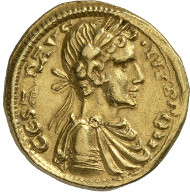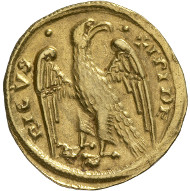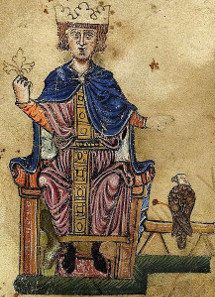courtesy of the MoneyMuseum, Zurich
translated by Teresa Teklic
Why was the human head the motif on coins for centuries, no, for millennia? And why did that change in the last 200 years? Ursula Kampmann is looking for answers to these questions in her book “Menschengesichter” (“Human faces”), from which the texts in this series are taken.
Frederick II, King of Sicily (1197-1250), Emperor of the Holy Roman Empire (since 1220). Half Augustalis. Bust of Frederick in Roman style with laurel wreath and drapery over his shoulder. Rv. Eagle, wings spread, turned to the left, head turned backwards. © MoneyMuseum, Zurich.
Frederick II, King of Sicily, grew up in Palermo, a city well-travelled by merchants from all over the world. Even if the boy from Apulia did not, as some hostile historians like to claim, prowl the streets of Palermo, he did have the opportunity to see the world with the eyes of other cultures in a way that his European contemporaries did not. This formed a personality that was truly remarkable. The people called him stupor mundi, wonder of the world, because his ideas were groundbreaking and pointed to a world far beyond that of the Middle Ages.
In other words, Frederick liked to enquire after uncomfortable truths. And answers he did find, no matter where he had to look for them. When Christian clergymen weren’t able to adequately prove the existence of the soul, he turned to the Islam with his question, an act that medieval chroniclers deemed was telling of his impiousness.
Frederick II with his falcon. From his book “De arte venandi cum avibus” (“On The Art of Hunting with Birds”), South Italy between 1258 and 1266. Source: Wikicommons.
No wonder such an emperor was exiled. No wonder that, still today, there are anecdotes of experiments that Frederick did allegedly conduct, but which surely did not happen in the way described.
It was an attempt of uncomprehending chroniclers to grasp the unbelievable fact that this Emperor accumulated knowledge himself instead of learning it from the books. Incredible as it may seem, Frederick wrote in one of his books on the art of falconry: “We discovered by hard-won experience that the deductions of Aristotle, whom we followed when they appealed to our reason, were not entirely to be relied upon, more particularly in his descriptions of the characters of certain birds. There is another reason why we do not follow implicitly the Prince of Philosophers: he was ignorant of the practice of falconry […]”
This free spirit, who didn’t believe that religion should ever stop you from engaging critically with the world, changed and renewed everything he touched. The administration of his Kingdom of Sicily was organised by Frederick in a way that would do any enlightened 18th century ruler proud. And his coinage was to become a bridge between Antiquity and Renaissance.
After all, unlike in the rest of Europe, Antiquity was omnipresent on Sicily. The epoch had left its remnants everywhere. So Frederick took the Roman emperors’ omnipotence as example and modelled himself in Roman fashion: with the laurel wreath and the coat draped over his shoulder. Although the Augustales of Frederick II of Sicily do not yet show a proper ruler’s portrait, they foreshadow the rebirth of Roman culture in the Renaissance.
In the next episode, we will tell you what happened to the Kingdom of Sicily after Frederick’s death.
How Frederick came into power, you will find here.
If you want more about Frederick II, please read the article on the Italian 1 Euro Cent.
You can find all episodes in the series here.
A German edition of the book “Menschengesichter” is available in print and as ebook on the site of the Conzett Verlag.






